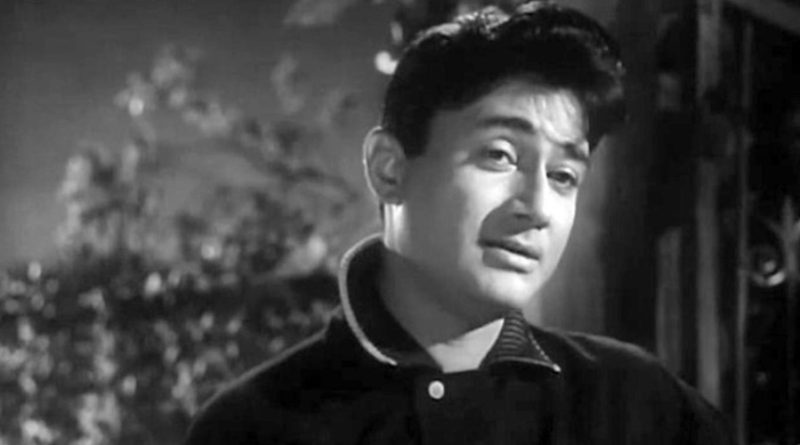It was a busy, rainy day.
I was driving to a Bandra studio. The editor had not showed up. All assistants were running late due to torrential rains. At 3 pm, it was dark. Clouds were thundering on a loop and my phone was ringing non-stop as the clients had booked all the slots on TV and any further delay would mean huge loss to them. I sat down holding my head.
At 3.15, my phone rang. It was an unknown number. A Production Exec. spoke on the other side. He was calling from Navketan and inquired if I would be interested in doing a project for them. “Navketan? Which Navketan?”, I asked, a bit curtly. “Sir, there is only one Navketan in Bollywood, Devsaab wala Navketan.” He answered, coolly.
Suddenly, background music started playing in my mind. ‘Tic tic doom doom, tic tic doom doom…’ the prelude of Jewel Thief’s brilliant song ‘Yeh Dil na hota bechara’, played in my mind. The imagery of this song flashed in my mind: The doors of Vishambar Das Jeweler’s open and comes out a man in beige trousers, brown corduroy blazer, cream scarf and a cigarette stuck on the left side of his lips. Cut to a car full of sexy girls, and walking ahead of them, in the middle of the road, is the same man with a fishing rod on his shoulder and a white fish hanging on the line. This man with his dark flashing eyes, black wavy hair, and deadly smile had set millions of female hearts a-flutter. This man was Dev Anand, the Gregory Peck of India.
Johny Mera Naam was the first film of Dev Anand that I had seen and had instantly became a fan of its director -Vijay Anand. Hare Rama Hare Krishna was the second film of Dev Anand that I saw and it made me a Pancham fan, for life. Thereafter, I saw almost all films of Devsaab, mostly for Pancham’s music and the pretty girls he discovered. But I wasn’t a true Dev Anand fan. I liked him for he worked with Goldie and Pancham. That’s it.
An old, wrinkled man received me at the gate and asked to wait in the lobby of Anand Studios. The old man stood there for few minutes, then he noticed something and started walking towards the other corner of the lobby. He stopped in front of a vintage poster, which was slightly off balance. He adjusted it, looked at me, smiled and disappeared. His smile told me that he was a part of this film. This was the poster of ‘Taxi Driver’. ‘Jaayen to jaayen kahan…’ flashed. I slowly turned around. The lobby was full of Navketan films posters.
Funtoosh, Kaala Bazar, Kala Pani, Hum Dono, Tere Ghar Ke Samne….Guide, Jewel Thief, Hare Rama Hare Krishna, Des Pardes…. Love at Times Square, Mr. Prime Minister. At that moment if a Genie had granted me one wish, I’d have asked for a body of work like this. And the music to die for. There was a list of Navketan discoveries: Guru Dutt, Jaidev, Raj Khosla, Johny Walker, Vijay Anand, Yash johar, Sahir Ludhiyanvi, Neeraj, Zeenat Aman, Shatrughan Sinha, Jackie Shroff, Shekhar Kapur, Tabu, Shabana Azmi, Udit Narayan, Abhijeet and many more.
A production executive took me to the top floor. This was Devsaab’s penthouse. It opened to an extremely large hall with scattered seating. It was dimly lit, in warm light. There was large seating at the centre where Devsaab sat at the corner of a L shaped sofa. This sofa was filled with letters, invitations and phone numbers. On his side, there was a corner table with a bright, warm lamp giving him nice highlights. There were several, old-fashioned dial phones, in different colours and more papers. The centre table had lots of newspaper cuttings and lots of handwritten, incomplete scripts-in-progress. There were piles of books, like skyscrapers of Nariman point, all over the carpet.
Devsaab saw me and smiled like how old friends smile when they meet after a very long time. I have never seen any star smile like that. It is very difficult to describe but I’d say there was oozing confidence and humble equality in his smile. I was charmed. “Agnihotri, come in”, and in the same breath Devsaab screamed, “Sorry Agnihotri, I made you wait”. This was the first time anybody had addressed me with my last name. “No, it’s ok”, I said humbly and walked towards him. “No, it’s not ok. That’s the problem with us Indians; we always say it’s ok when it’s not. I have learnt through experience that time is half of a film’s budget. Money is the second half”, said Devsaab.
Without wasting any time, he straightaway came to the purpose of the meeting. One could feel that for him time was precious. The urgency in his tone had a lot of passion in it. His body language was raring to go. He would get up while talking. There was such organic energy all around as if dullness, boredom and lethargy never ever visited this man’s life. He told me that some NRIs had pooled in funds and wanted to make a documentary on him. Devsaab said he had agreed on the condition that the director would be of his choice. Suddenly, out of nowhere, he asked me, “Are you a fan of Dev Anand?”. I wasn’t prepared for this question in my wildest dreams. There was such honesty and sincerity in his manner that it was impossible to lie. “Sir, you are a legend… I respect you a lot but I grew up mostly in Amitabh Bachchan’s era”. Devsaab stood up. He then told me, “I had three conditions. a) the director shouldn’t have worked with Dev Anand, b) the director shouldn’t be known to Dev Anand and c) the director shouldn’t be a fan of Dev Anand.”
He started pacing up and down. “In a documentary, the subject and observer should be two different things. Subject should be separate from the observer. That’s why it’s called documentary… documenting things. Films are different… in films, the subject and observer should become one. When the observer and subject merge, classics happen. Everyone in this world is looking for that one classic in his life. We give them hope that it is possible.” I had never ever imagined a box-office attraction, a style icon, superstar of romantic heroism, Dev Anand to speak such film philosophy.
I looked around. Strangely, there wasn’t any trophy, awards or any self-promotional property. Only scattered papers and 5-6 phones. Strange because all star houses I have been to are like museums of trophies and other narcissistic properties. He was wearing old corduroy trousers with American folds, which had a few holes. He wore an old-fashioned shirt with long collars, a jacket and a sweater thrown over his shoulders in a typical Dev Anand style. With age, his shoulders were drooping, but his confidence was overwhelming. He looked straight in my eyes with a hint of a smile. I had heard about aura, but saw it that day. He wasn’t like any other film folk. He came across as a man in a hurry to experience life. A dynamic, youthful, creative aura is what I experienced that day. Everything around him had a vintage feel. Everything about him had a modern, liberal feel.
He was a walking contradiction. I found him a fearless, passionate, progressive man who was full of ideas. Devsaab spoke non-stop about how his life was about finding stories. After every few sentences he said, “Agnihotri, …there are so many stories to tell…. I don’t have time… I have to tell them quickly….”. He must have narrated more than 15 one liners to me that day, which were unique. He said stories are all around us. In newspapers, in trains, in markets… “Wherever there are people, there are stories. As long as you look at people, you want to tell stories. These stories will stop, when I stop.” I tried to remember his body of work and realised most of his films had unique story ideas. Be it black marketing, drugs, migrants in UK, politics, Indo-Pak relationship or even censorship. He spoke against the Emergency and challenged Indira Gandhi. He wasn’t afraid of success and failure, he wasn’t afraid of life and death. He told me, “I want to die telling a story.”
He was preparing for his next film when he died peacefully in his sleep on December 2011. He wanted his documentary to be about his stories. Not the success and failure of films. He was pretty fond of Mr Prime Minister. He showed me hundreds of fan letters praising him for this film. He was the first and the last star I have met, who didn’t even once speak about his past. No anecdotes, no trivia, no gossip. He spoke about films he was planning. The talent he was auditioning. Showreels he was seeing. He narrated how he shot Love at Times Square on New Year’s eve. He thought that was his life’s unique achievement. Apparently, his DOP was old and couldn’t manage guerilla style shooting. So, he got a young, American cameraman who could run at Devsaab’s pace. Love at Times Square was from his life. He had met a young girl at Times Square who occupied his mind. “I had to tell this story else it would have haunted me. I need space for new stories.”
At that time I was just an Ad film maker. Today, after 10 years in film making, I truly understand this obsession with stories. Stories put our life in perspective. Stories help us sort things in our minds. It was all sorted in Devsaab’s mind. He had his priorities very clear – Stories, love and beauty, exactly in this order. His stories are all set in his time. Always, in the present. Like his own life. I asked him, “You are a producer, director, writer, actor, star… how would you describe yourself in one word?”. ‘Story maker’, he replied, with absolute clarity. Before leaving, I told him, “Devsaab, nobody has discovered so much talent as you. I think this can be the theme of this documentary. You built such a creative environment where talented people flourished…”. He held my hand and said very warmly, “Dev Anand doesn’t discover anybody. They find Dev Anand”. On that rainy, busy day I had also found Dev Anand -The Story Maker.


